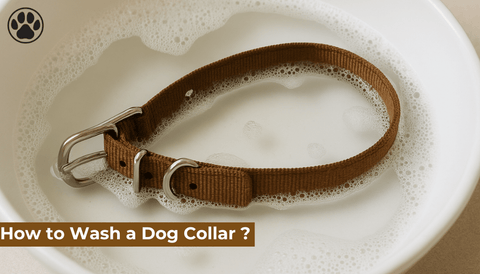
What Is an E-Collar for Dogs ?
of reading - words
Understanding how to properly train and care for your dog often involves exploring different tools and techniques. One such tool that frequently sparks discussion is the e-collar for dogs. Also known as an electronic collar, remote training collar, or shock collar, this device is used to assist with obedience training and behavior correction.
In this guide, we’ll break down everything you need to know about e-collars—how they work, their pros and cons, and how to use them responsibly to ensure the wellbeing of your pet.
What Exactly Is an E-Collar?
An e-collar is a type of dog training collar that delivers a mild electric stimulation (or vibration, or beep) to the dog's neck. The goal is to get the dog’s attention and discourage unwanted behavior, such as excessive barking, jumping, chasing, or ignoring recall commands.
Most modern dog e-collars come with multiple settings that allow owners to control the intensity of the stimulation. This helps tailor the correction to the size, temperament, and sensitivity of the dog.
How Does an E-Collar Work?
An electronic collar typically consists of two parts:
-
A remote control held by the owner or trainer
-
A receiver worn around the dog's neck
When a behavior needs correction or reinforcement, the handler presses a button on the remote to activate the receiver. Depending on the setting, the collar may produce a vibration, a beep, or a low-level electrical pulse.
Importantly, e-collars are not meant to punish dogs but to redirect them and reinforce proper training in a timely manner. The immediate feedback helps dogs associate their actions with the consequence, which supports faster learning.
Benefits of Using an E-Collar for Dogs
Many professional trainers and pet owners use e-collars as part of a broader training approach. Here are some of the main benefits:
-
Improved recall: Helps reinforce commands such as “come” or “stay”
-
Distance control: Useful for off-leash training or wide outdoor spaces
-
Interrupting unwanted behaviors: Reduces chasing, digging, barking, or aggression
-
Customizable settings: Adjustable intensity ensures safe, humane correction
When used properly and with guidance, e-collars for dogs can be a helpful addition to positive reinforcement training techniques.
Risks and Considerations
While e-collars can be effective, they must be used responsibly. Here are some key considerations:
-
Not for young puppies: Most experts advise waiting until a dog is at least 6 months old
-
Training required: The handler should be familiar with proper usage to avoid accidental misuse
-
Avoid overuse: Consistent corrections without reward can stress or confuse the dog
-
Poor fit or malfunctioning gear: May cause discomfort or skin irritation
Always consult with a certified dog trainer or veterinarian before starting e-collar training, especially if your dog has behavioral issues or health conditions.
Types of E-Collars
There are several types of e-collars, each designed for specific training needs:
-
Static stimulation collars: Deliver adjustable electrical pulses
-
Vibration collars: Use vibration instead of shock, ideal for sensitive dogs
-
Tone collars: Emit a beep or sound signal to gain the dog’s attention
-
Anti-bark collars: Automatically respond to barking with correction
Choose a collar that matches your dog’s behavior, your training goals, and your personal values regarding humane correction.
E-Collar vs Regular Dog Collar
Unlike a regular dog collar, which is mainly used for identification and leash attachment, an e-collar is an active training device. That said, every dog should have a comfortable daily collar that reflects their personality and supports everyday use.
If you're looking for high-quality dog collars, check out our exclusive collection of durable, stylish, and breed-appropriate collars. Whether you want classic leather, tactical designs, or reflective nylon, you'll find the perfect option to complement your dog’s e-collar when it's not in use.
👉 Explore our dog collar collection for everyday style and comfort.
How to Use an E-Collar Responsibly
Here are best practices when training with an e-collar:
-
Start with the lowest setting: Increase only if your dog doesn’t respond
-
Use a cue first: Pair the collar signal with a voice command or hand signal
-
Limit session duration: Keep training short (10–15 minutes)
-
Reward good behavior: Combine the e-collar with treats or praise
-
Avoid emotional use: Never use the collar when you’re angry or frustrated
Ethical Considerations
While some view e-collars as controversial, it’s important to focus on how the tool is used. When applied with proper technique, timing, and empathy, the e-collar can be a safe and effective training aid. The misuse of any training tool, including standard leashes or crates, can result in distress. The key is education, moderation, and respect for your animal.
Frequently Asked Questions (FAQ)
Is an e-collar the same as a shock collar?
Yes, "shock collar" is a more controversial term for e-collar. However, modern e-collars have adjustable, low-level stimulation settings and often include beep or vibration options.
Are e-collars safe for dogs?
Yes, when used properly, they are safe. They are not painful but designed to get the dog's attention. Always follow the manufacturer's guidelines.
At what age can I start using an e-collar?
Most trainers recommend starting at 6 months or older, depending on the dog’s development.
Can e-collars be used on all breeds?
Yes, but they are particularly helpful for large, strong-willed, or active breeds. Smaller dogs may require collars with gentler stimulation options.
Do e-collars replace other training methods?
No. They should complement positive reinforcement, not replace it. Use treats, praise, and play in combination with the collar.




